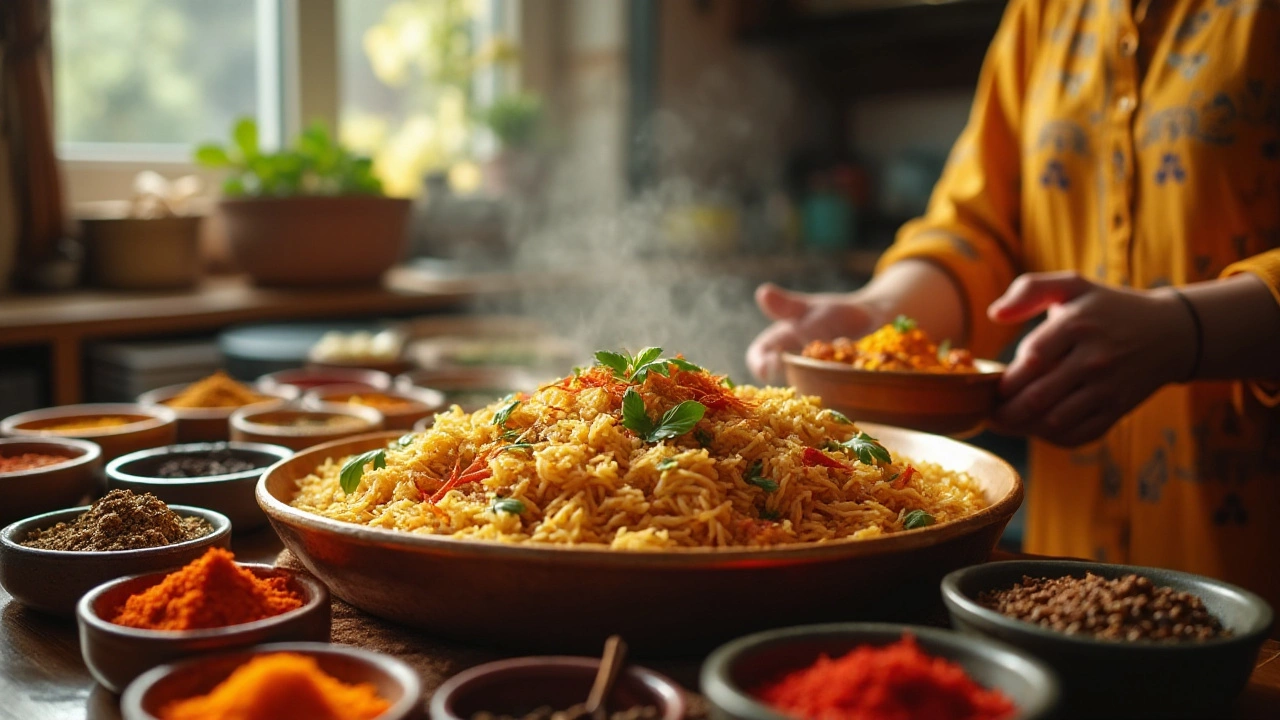Biryani captivates food enthusiasts around the world with its aromatic blend of rice, meat, and spices. Yet, there are times when we find our biryani lacking the punch we expected. If you have ever wondered why your biryani does not quite hit the mark, you are not alone. Many face this challenge, but the solution isn't far off.
Creating a flavorful biryani is both an art and a science. It involves a spectrum of ingredients working together in harmony. From choosing spices that sing to ensuring each step enhances the intended flavors, every decision in the cooking process matters. Join us as we unravel the culinary secrets behind making a biryani that delights the palate and stands as a testament to this classic dish's reputation.
- Understanding the Role of Spices
- Importance of Fresh Ingredients
- Balancing Flavors with Precision
- Mastering the Cooking Technique
- Tips for Serving and Storing
Understanding the Role of Spices
Spices are at the heart of any great biryani recipe, and understanding how they function can transform a bland dish into something truly spectacular. When you think of biryani, a symphony of flavors should come to mind—a delicate balance where each spice has its own melody yet contributes to the harmony of the whole. It's not just about adding spices but about understanding their individual characteristics and how they interact. Each spice brings its own unique flavor profile, aroma, and color, working together to elevate the dish.
Let's explore some of the key players: cumin provides earthiness and warmth, while coriander seeds introduce a slight citrus undertone. Cardamom offers a sweet, floral note, whereas cloves add a hint of bitterness that balances out the richness of the dish. These spices must be used in the right proportions; too much can overpower the dish, and too little might leave it tasting flat. A common mistake is failing to use freshly ground spices. Pre-ground options may offer convenience but often lack the intensity and complexity of freshly ground ones.
An ancient Indian proverb reminds us,
The spice must flow, and its path must be respected.Grounding our spices fresh not only ensures that aromatics are at their peak but also allows for a deeper integration of flavors. The difference is remarkable and is something you must experience to truly appreciate. Moreover, the order in which you add spices to your biryani can significantly affect the flavor profile. Dry-roasting whole spices before grinding them can unlock their full potential, leading to a richer and more complex biryani.
The choice of spices is not just about taste but aroma as well. During the cooking process, spices release essential oils that contribute to the dish's fragrance, an integral part of the dining experience. The smell of well-cooked biryani should have the power to make mouths water long before the dish reaches the table. This is where precise timing comes into play. Incorporating spices at different stages of cooking can yield distinct levels of fragrance and flavor. Timing, as much as selection, is key to a flavorful biryani.
Lastly, let's not overlook the power of marination. Allowing your meat to soak in a spicy marinade is crucial for infusing it with flavor. A blend of yogurt and spices not only tenderizes the meat but ensures its flavor penetrates deeply. It's a step that should never be rushed; patience will reward you with a biryani that is both flavorful and aromatic. Understanding the role of spices in biryani is a journey, one that requires curiosity and practice. Experiment with different spice combinations, keep an eye on proportions, and don't shy away from adjustments until you achieve the perfect balance. With each iteration, you'll be one step closer to mastering the art of making an unforgettable biryani.
Importance of Fresh Ingredients
When it comes to cooking a biryani that tantalizes the senses, the freshness of your ingredients plays a pivotal role. Imagine preparing a dish as intricate as biryani, where each component adds its unique essence to the mix. Fresh ingredients not only raise the flavor profile, but they also ensure your experience is as authentic as it gets. Fresh spices, for instance, bring an unmistakable aromatic intensity that powders from an off-the-shelf jar just can't replicate. The difference is not just in the scent but also in the taste, giving your biryani its signature rich warmth and complexity.
Investing time to source fresh produce is essential for a delightful biryani. Fresh onions and tomatoes contribute sweetness and tanginess that enhance the blandness of any dish. When you peel back that onion and detect a subtle, sharp aroma, you know it’s going to step up your dish. Likewise, using freshly ground spices such as cardamom, cloves, and cinnamon can transform your cooking experience. Not only do they swirl into a more vivid blend of flavors, but they also infuse the entire kitchen with an intoxicating smell that promises a meal to remember.
In one of her many cooking insights, the renowned Indian chef Madhur Jaffrey once said,
"The key to superior Indian food is fresh ingredients. It's the singular magic that defines and redefines a classic flavor."When every ingredient is fresh, every element comes to life with increased vigor. Whether it's the cool dill and mint enhancing aroma or the vibrant, juicy chicken or vegetables soaking in the marinade, fresh always works better. For the rice itself, using high-quality, fresh basmati is a game-changer. It brings forth a fluffier grain while absorbing the spiced broth to perfection, unlike any stale counterpart. Rice is the heart of biryani, and a fresh sack resonates that pivotal 'pop' when cooked right, delivering that unparalleled texture and aroma.
One can say sourcing local ingredients is also an effort to honor the cultural roots of this dish. Go to a farmer’s market, strike up a conversation, and find out what’s just been plucked fresh. Often, the journey of seeking out quality ingredients becomes a story in itself. It adds to the anticipation of creating a masterpiece. Biryani deserves not just fresh ingredients, but those procured with love and intention, ensuring your dish transcends beyond the ordinary every single time. Freshness is the undercurrent of balance and harmony in your biryani, making each bite a memorable festival of flavors.

Balancing Flavors with Precision
Crafting a remarkable biryani often boils down to achieving the perfect balance of flavors, a task that requires care and attention. The combination of fragrant basmati rice, tender meat, and the right blend of spices is essential in defining this dish’s unique taste profile. To ensure your biryani becomes a masterpiece, attention must be given to the harmony of sweet, salty, and spicy elements. Key to this process is understanding how spices interact with one another. The magic lies in the subtle distinctions between ingredients: saffron contributes a lovely aroma and a hint of sweetness, while green cardamom adds a fresh, zesty note. It's not merely about throwing spices together but making them sing in unison to create a symphony of flavors.
One common mistake is the overuse or underuse of certain ingredients, which can drastically alter the finished dish's taste. For instance, inadequate marination or seasoning of meat often results in a bland biryani. To avoid such pitfalls, be generous but mindful with spices, ensuring each one's voice is heard in the chorus, without overpowering others. Consider ratios when adding ingredients like cumin, coriander, and chili powder, as they can greatly influence the final product. A helpful method is to start by adding less, tasting as you go and adjusting to suit your preference, a practice that encourages personalizing your dish to meet your flavor expectations.
In the words of celebrated chef Madhur Jaffrey,
"Spices are like our friends; the right combination brings out the best in us."Enhancing biryani with natural enhancers such as fried onions or fresh herbs like mint and coriander not only adds depth but helps in balancing the robust flavors of the dish. Onions provide a caramelized sweetness, while the herbs add freshness, preventing the dish from tasting flat or one-dimensional.
Understanding the role of acids is another vital step in balancing flavors. Ingredients such as lemon juice or yogurt play a pivotal role by adding brightness and cutting through richness. These acids help blend the flavors smoothly, ensuring that the distinct taste of one component elevates rather than dulls the others. The acid's role in cooking the rice and meat to achieve moistness shouldn’t be underestimated, as it contributes to both the texture and flavor profile of the biryani.
As a handy guide, here’s a flavor-enhancement strategy to follow: when mixing your spices, always aim for a balanced proportion, considering taste preferences and dietary needs. To aid in visualizing this, here's a simplified spice balance table to keep in mind:
| Spice | Quantity (for 500g meat) |
|---|---|
| Turmeric | 1 tsp |
| Chili Powder | 1.5 tsp |
| Coriander Powder | 2 tsp |
| Garam Masala | 1 tsp |
Whether you aspire to replicate your grandmother's secret recipe or innovate your signature version, remembering the intricate balance of flavors will transform your biryani from ordinary to extraordinary. Relishing each spoonful should feel like a journey through a vibrant terrain of tastes, where no single flavor outshines the other but rather combines to tell a beautiful story.
Mastering the Cooking Technique
Creating a truly exceptional biryani requires mastery over its cooking technique, a task that can be just as challenging as perfecting the selection of spices. To achieve the perfect *biryani recipe*, one must understand the importance of layering flavors and textures precisely. This begins with the decision between using the dum (slow-cooking) method or stovetop technique. Each method demands attention to detail—ensuring the rice cooks to the right doneness, while **maintaining** the tender juiciness of the meat. With the dum method, the key is the act of sealing the pot with a dough or tight lid, allowing the contents to cook in their own steam, which melds the flavors beautifully without escaping.
The timing and sequence of ingredients are imperative to master. Parboiled basmati rice—long-grained and aromatic—is crucial for achieving the characteristic fluffy texture. Cooking rice to about 70% doneness before the final layers prevents excess moisture from turning it mushy upon completion. When layering, alternate the rice with marinated meat or vegetables, and sprinkle fried onions, saffron-infused milk, and ghee for depth of flavor. Each layer should be treated meticulously, allowing the rice to absorb the rich flavors from the meat and spices. As one industry expert once said,
"A perfect biryani is like a symphony, with each layer harmoniously contributing to the melody of the dish."Timing here is everything—not just in preparation but also in regard to marinating meat. Longer marination times enrich the flavor profile, ensuring that spices penetrate deeply, making your biryani stand out.
A crucial aspect of *cooking biryani* is maintaining the correct heat levels. Begin with a high flame to activate the cooking process and then reduce to low, allowing for a slow and even heat distribution. For those employing the dum method, use a heavy-bottomed pot to avoid burning, and occasionally place the pot on a griddle to further disperse the heat. This ensures that not a single grain is overcooked while the meat cooks to tender perfection. An effective tip is to listen for the sizzling sound, an indicator that the food inside is cooking well. Other adjustments can be made based on aroma; this requires practice but is worthwhile in achieving an excellent biryani.
One common mistake to avoid is over-stirring the mixture once it is layered. Resist this urge, as stirring disturbs the layers and results in a homogeneous mix that doesn't allow distinct flavors to shine. To serve, use a large spoon to dig deep, ensuring each scoop captures both layers of rice and the beautifully cooked meat. Remember, the presentation is as vital as taste; the sight of perfect layers adds to the enjoyment of consuming biryani.
For an authentic experience, consider serving biryani on a banana leaf—a traditional method that was popularized centuries ago in Southern India. It not only looks beautiful but adds a subtle, earthy aroma to each serving. Based on your taste preferences, paired sides like raita, pickled onions, or even a boiled egg can elevate the meal further. Paying close attention to these aspects of cooking biryani can transform what might be a bland finale into a symphony of flavors that captivates the senses. Keep experimenting, stay precise, and remember, the art of biryani lies as much in its technique as in its flavor.

Tips for Serving and Storing
The way you serve your biryani can significantly enhance the tasting experience, ensuring every aromatic note and burst of flavor is savored. Begin by fluffing the rice gently with a fork to separate the grains before serving. This simple step prevents clumping and releases the enticing aroma of the spices. Serve biryani with sides like raita or a tangy salad to complement its flavorful profile. Garnishing with fresh cilantro or mint can add a burst of color and a hint of fresh aroma that enhances the visual appeal and taste.
Consider using traditional serving methods such as clay pots to keep the biryani warm and to enhance the dining experience. These pots are not only functional but add a rustic charm that many find appealing. If you want to be particularly authentic, present your biryani on a banana leaf which is a practice in some cultures. This method adds an earthy, natural touch that some say enhances the subtle flavors of the dish.
Storage Techniques
Proper storage is essential if you find yourself with leftovers, as storing biryani incorrectly can lead to a loss of flavor and moisture. Allow the biryani to cool at room temperature for no more than two hours after cooking to prevent bacterial growth. Once cooled, transfer it to shallow airtight containers before placing it in the refrigerator. Shallow containers ensure even cooling and retain the flavors better. Biryani can typically be stored in the refrigerator for up to four days.
For those who prefer to prepare biryani in advance, freezing is a viable option. To freeze, pack the biryani into airtight freezer-safe containers or heavy-duty freezer bags. Ensure as much air as possible is removed to prevent freezer burn. Frozen biryani can be stored for up to one month; beyond this, you risk dulling the flavors. Always label containers with dates to keep track of freshness.
“Properly stored, biryani retains its vibrant flavors and delightful aroma, transforming a simple next-day meal into another feast.”
When it comes to reheating, use gentle methods to maintain the dish's integrity. The ideal method is to steam the biryani using a double boiler setup or a steamer basket. If you are using a microwave, sprinkle a bit of water over the rice to keep it moist and cover loosely to prevent drying out.
Explore these serving and storing tips to elevate the biryani dining experience, making every bite as satisfying as the first. Each method contributes to how well your flavorful biryani is preserved, ensuring it remains a dish everyone will remember. Whether consumed fresh or after being stored, your biryani should always bring joy and contentment to the dining table.
